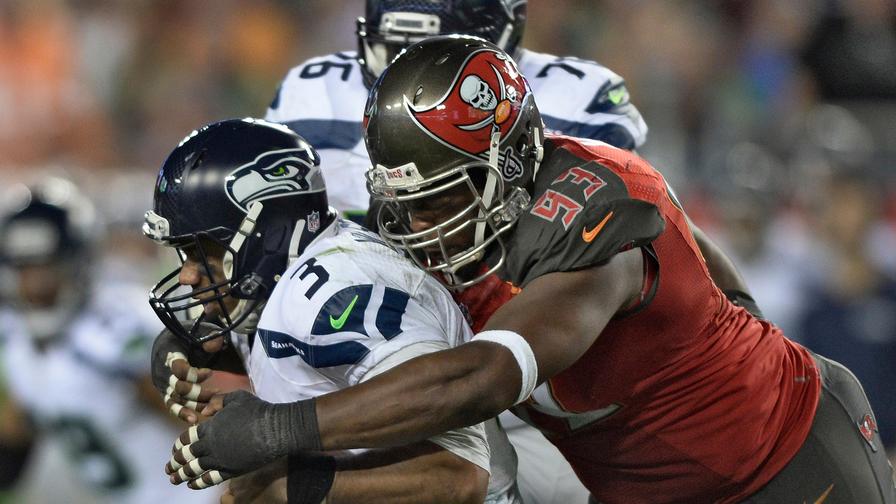Fantasy Football: The Tampa Bay Buccaneers' Defense Will Likely Regress in 2017

Last season marked the first time in a long time that the Tampa Bay Buccaneers had an above-average scoring defense.
After ranking 21st or worse in every season since 2011, the Bucs allowed 23.0 points per game last year, finishing 15th. They were also 13th in our schedule-adjusted Net Expected Points per play (NEP) metric. This measures each individual play’s impact on the score of the game, and adjusts for the quality of the opposing offense. Check out our glossary for more information on NEP.
For fantasy owners, Tampa Bay finished in 11th in points in standard leagues.
On the surface, it may seem like the 2017 Buccaneers could provide decent value at the end of your draft, especially as your peers spend more draft capital on super-hyped defensive juggernauts like Denver and Houston.
But you should proceed with caution, as there are a number of red and yellow flags that suggest Tampa Bay's 2016 performance is not sustainable.
Turnovers Are Random
The volatile rates of turnovers is a piece of football stathead orthodoxy that has generally yet to permeate the mainstream. Studio commentators frequently say that “Team A†has to win the turnover battle in order to beat “Team B.†This is true, but they often leave out the fact turnovers are largely unpredictable.
Last season, for example, the top six teams in turnover differential in the first half of the season combined to have a plus-51 margin. In the second half, this group was only plus-6, and just two of these squads even had a positive turnover margin.
On the other hand, three of the bottom six teams in turnover margin in the first half had positive turnover differentials in the second half.
This is something that has been looked at extensively by others, and the conclusion is always the same: turnovers are random.
This should be alarming for the Buccaneers, as takeaways were the primary reason for their success on defense in 2016. Their opponents were able to move the ball relatively easily, as Tampa Bay ranked 25th in yards allowed per play (5.8). The Bucs compensated by ranking third in the league in turnovers per play and second in turnovers per drive.
This does not seem like a sustainable means of having a good defense, as yards per play is a more consistent measure of defensive strength. Since 2012, it has correlated with itself from one year to the next with a coefficient of 0.38, with next-season point scoring at 0.22 (1 implies a perfect correlation and 0 implies none).
It’s hardly the strongest relationship, but it also blows turnover rate out of the water. Turnovers per play in one season correlate with turnover rate in the next at just 0.12, with next-season point scoring at -0.07.
Tampa Bay’s defense was fourth in the NFL in fumble recovery rate, coming up with the ball on 57.1% of opponents' fumbles. Generally speaking, we would expect a team to come up with 50% of fumbles, as there is no consistency to fumble recovery rates.
Their turnovers by air will also probably be less frequent in 2017. The Buccaneers tied for the NFL lead in interception rate (3.1%), but they were just 18th in completion percentage against (63.3%).
Completion percentage is one of the more stable defensive stats -- it correlates with itself at 0.52 from one year to the next -- while interception rate is one of the more random (0.17). In fact, over the past five seasons, completion rate is actually slightly more predictive of interceptions than interception rate itself (-0.23, meaning that as completion rate increases, interception rate decreases).
Knowing what we know about turnover volatility, there is no assurance that Tampa Bay will be able to maintain its high takeaway rate in 2017. Without it, the team will need to stop opponents from gaining yardage, something it struggled with last season.
Other Factors
Forcing turnovers is not the only thing the 2016 Bucs excelled at that may not carry over into 2017.
They generally stayed healthy last year, ranking sixth in adjusted games lost, per Football Outsiders. The Bucs also outperformed their baseline on the most important downs, leading the league in conversion rate on third- and fourth-down.
Like turnover rates, third- and fourth-down performance is generally volatile. Conversion rate in 2015 had no correlation with that in 2016 -- the coefficient was -0.09, suggesting, if anything, a negative relationship. This is also true in-season, as conversion rate in the first half does not predict this mark in the second at all (r = -0.06).
Overall defensive performance actually predicts future third-down performance substantially better from one year to the next. Yards allowed per play in 2015 correlated with third- and fourth-down conversation at 0.43.
Taking all of this into account, the Bucs' defense needs to be considered a prime candidate for regression in 2017, and instead of taking them in your draft, you'd be better off pursuing defenses with mouth-watering early-season matchups.
















